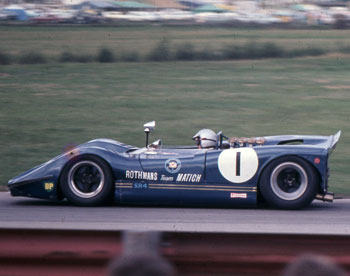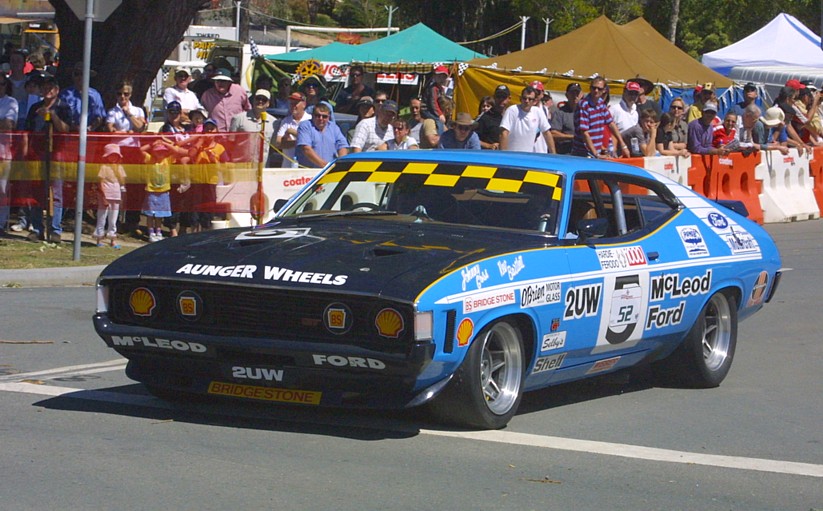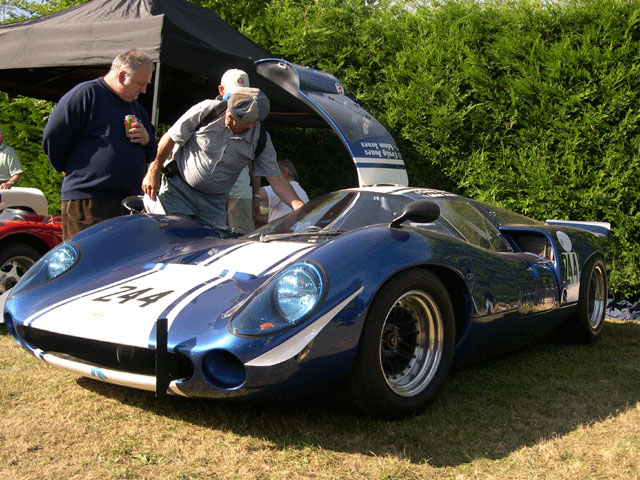|
1970 Australian Sports Car Championship
The 1970 Australian Sports Car Championship was an Australian motor racing competition for Group A Sports Cars, Group B Improved Production Sports Cars and Group D Series Production Sports Cars.CAMS Manual of Motor Sport, 1970, pages 78–82 It was authorised by the Confederation of Australian Motor Sport as an Australian National Title. The title, which was the second Australian Sports Car Championship,Records, Titles and Awards, 2006 CAMS Manual of Motor Sport, page 14-6 was won by Peter Woodward, driving an Elfin 350 Coventry Climax.Australian Sports Car Championship 1970, Australian Competition Yearbook, 1971, pages 108–113 Schedule The championship was contested over three heats with one race per heat. * Heat 1, Endeavour Cup, Phillip Island, Victoria, 25 January * Heat 2, RAC Trophy, Warwick Farm, New South Wales, 3 MayJim Morris, Allen Breaks Title Grip on RAC, Racing Car News, June 1970, pages 42–43 * Heat 3, Western Australian Sports Car Championship, Wanneroo Pa ... [...More Info...] [...Related Items...] OR: [Wikipedia] [Google] [Baidu] |
Australian Sports Car Championship
The Australian Sports Car Championship was the national title for sports car racing drivers sanctioned by the Confederation of Australian Motor Sport from 1969 to 1988. Each championship was contested over a series of races with the exception of the 1975 title, which was awarded on the results of a single race held at the Phillip Island circuit in Victoria. Championship races were open to purpose-built sports racing cars complying with CAMS Group A Sports Car regulations except for the years 1976 to 1981 in which they were restricted to Group D Production Sports Cars. Local manufacturers Matich, Elfin, Kaditcha, and K&A Engineering ( Veskanda C1), along with McLaren dominated the series when run under Group A rules, while Porsche drivers won all six Group D based championships. The championship winners are listed below. {, class="wikitable" style="font-size: 95%;" ! Year ! Champion ! Vehicle , - ! 1969 , Frank Matich , Matich SR4 Repco , - ! 1970 , Peter Woodward , ... [...More Info...] [...Related Items...] OR: [Wikipedia] [Google] [Baidu] |
Elfin Sports Cars
Elfin Sports Cars Pty Ltd (formerly known as Elfin Sports Cars) is an Australian car manufacturer company that was founded by Garrie Cooper. It has been an Australian manufacturer of sports cars and motor racing cars since 1959. Elfin Sports Cars is currently owned by the estate of former British racing driver Tom Walkinshaw, through his company Walkinshaw Performance which also owns Holden Special Vehicles. It was previously owned by businessmen and historic racing enthusiasts Bill Hemming and Nick Kovatch (who remains as technical director) who purchased it in 1998. Elfin is the oldest continuous sports car maker in Australia and one of the most successful with 29 championships and major Grand Prix titles. The original factory was located at Conmurra Avenue, Edwardstown in suburban Adelaide, South Australia. The company is currently located at Braeside, a suburb of Melbourne, Australia. History The company was founded in South Australia as Elfin Sports Cars in October 1959 b ... [...More Info...] [...Related Items...] OR: [Wikipedia] [Google] [Baidu] |
John Goss (race Driver)
John Goss (born 2 May 1943, in Glen Iris, Victoria) is an Australian retired motor racing driver who competed in his home country during the 1960s, 1970's and 1980's. He is the only driver to have won Australia's two most prestigious races, the Bathurst 1000 (1974 and 1985), and the Australian Grand Prix (1976). During his career, John Goss gained a reputation for long acceptance speeches, with many joking that his victory speech on the Bathurst podium following his 1974 win took almost as long as the race itself (the race, the first to be run in wet conditions, lasted 7 hours, 51 minutes and 43 seconds). Goss was awarded the Medal of the Order of Australia in 2018 for services to motorsport. Early career Having moved from Victoria to Tasmania as a child, Goss began racing in his adopted state in Holden FJs and Ford Customlines. He then built his own sports car, the Tornado Ford, which he took to the mainland with some success, scoring points in the Australian Sports Car Cha ... [...More Info...] [...Related Items...] OR: [Wikipedia] [Google] [Baidu] |
Elfin Mallala
The Elfin Mallala was a sports racing car produced in 1962 and 1963 by Garrie Cooper's Elfin Sports Cars. It had a small run of only five cars. Its first race was at the Mallala Race Circuit which gave its name to the car. It has the historical distinction of being the first Australian built racing car to race in England. Cars Technical specifications and features Drivetrain *mid mounted 4 cylinder, 1600 cc engine *From *5 speed gearbox Propulsion transmission is the mode of transmitting and controlling propulsion power of a machine. The term ''transmission'' properly refers to the whole drivetrain, including clutch, gearbox, prop shaft (for rear-wheel drive vehicles), differe ... Suspension *Front: Tubular wishbones, coil/shock absorbers, non-adjustable anti-roll bar *Rear: Reversed lower wishbones, driveshaft top link, trailing radius arms Exceptions were: :chassis 6318: tubular top link, splined driveshaft :chassis 6316: tubular top link, drive shafts with rubber d ... [...More Info...] [...Related Items...] OR: [Wikipedia] [Google] [Baidu] |
Ford Mustang (first Generation)
The first-generation Ford Mustang was manufactured by Ford from March 1964 until 1973. The introduction of the Mustang created a new class of automobiles known as the pony cars. The Mustang’s styling, with its long hood and short deck, proved wildly popular and inspired a host of competition. It was initially introduced on April 17, 1964, as a hardtop and convertible with the fastback version put on sale in August 1964. At the time of its introduction, the Mustang, sharing its platform with the Falcon, was slotted into a compact car segment. With each revision, the Mustang saw an increase in overall dimensions and in engine power. The 1971 model saw a drastic redesign to its predecessors. After an initial surge, sales were steadily declining, as Ford began working on a new generation Mustang. With the onset of the 1973 oil crisis, Ford was prepared, having already designed the smaller Mustang II for the 1974 model year. This new car had no common components with preceding m ... [...More Info...] [...Related Items...] OR: [Wikipedia] [Google] [Baidu] |
Bob Jane
Robert Frederick Jane (18 December 1929 – 28 September 2018) was an Australian race car driver and prominent entrepreneur and business tycoon. A four-time winner of the Armstrong 500, the race that became the prestigious Bathurst 1000 and a four-time Australian Touring Car Champion, Jane was well known for his chain of tyre retailers, Bob Jane T-Marts. Jane was inducted into the V8 Supercars Hall of Fame in 2000. Early life Bob Jane grew up in Brunswick, an inner-city suburb of Melbourne. His passion for racing began in the early 1950s as a champion bicycle rider, holding many state records before turning to four wheels. In the later 1950s, he started Bob Jane Autoland, a company that distributed parts for Jaguar and Alfa Romeo. Through this venture, a love of cars and motor sport blossomed and he first entered competitive racing in Australia in 1956; by 1960, he was racing with some of Australia's top sedan drivers. Racing career In 1961, Jane and co-driver Harry Fir ... [...More Info...] [...Related Items...] OR: [Wikipedia] [Google] [Baidu] |
Lotus 23
The Lotus 23 was designed by Colin Chapman as a small-displacement sports racing car. Nominally a two-seater, it was purpose-built for FIA Group 4 racing in 1962–1963. Unlike its predecessors Lotus 15 and 17, the engine was mounted amidship behind the driver in the similar configuration developed on Lotus 19. The 23 To comply with FIA rules, it had a regulation trunk space to the right-rear of the driver, a windshield wiper, a horn, pairs of headlights and tail lights, rear center license plate light, a wire-operated emergency brake, and a mounting space for one spare tire under the front body. The 23 used a wider version of the Lotus 22 space frame, clothed in a fibreglass body. It was originally intended for engines of 750 cc to 1300 cc (45-80ci) with a Renault 4-speed transaxle, but had a 5-speed Hewland Mk.III in production, which used the entire Volkswagen magnesium alloy transaxle case in upside-down configuration, housing bespoke straight-cut gears with dog-rings, an ... [...More Info...] [...Related Items...] OR: [Wikipedia] [Google] [Baidu] |
Repco
Repco is an Australian automotive engineering/retailer company. Its name is an abbreviation of Replacement Parts Company and was for many years known for reconditioning engines and for specialized manufacturing, for which they gained a high reputation. It is now best known as a retailer of spare parts and motor accessories. The company gained fame for developing the engines that powered the Brabham Formula One cars in which Jack Brabham and Denny Hulme won the 1966 and 1967 World Championship of Drivers titles respectively. Brabham-Repco was awarded the International Cup for F1 Manufacturers in the same two years. Repco currently runs a series of stores across Australia and New Zealand specialising in the sale of parts and aftermarket accessories. The company was founded by Robert Geoffrey (Geoff) Russell in 1922 and first traded under the name Automotive Grinding Company, from premises in Collingwood, Victoria. It currently has over 2,000 employees in almost 400 store ... [...More Info...] [...Related Items...] OR: [Wikipedia] [Google] [Baidu] |
Matich SR4
The Matich name was applied to a series of sports racing cars and open wheel racing cars produced in Australia between 1967 and 1974 under the direction of Sydney-based racing driver and engineer Frank Matich.The Macquarie Dictionary of Motoring, 1986, page 296 SR3 The Matich SR3 was a Group A Sports Car built for Matich by Bob Britton in 1967. It was powered by an Oldsmobile V8 engine and was driven to victory by Matich in the 1967 Australian Tourist Trophy, Australia's premier sports car race of that year. Later in the year, Matich raced in both the US Can-Am series and in Australia, with two SR3s fitted with 4.4-litre Repco V8 engines. Matich won the 1968 Australian Tourist Trophy with a Repco powered SR3. File:Matich-SR3-Graham-Ruckert.jpg, The Matich SR3 in the pits at Surfers Paradise in mid-1968 File:Matich SR3 Mont-Tremblant Bridge.jpg, Re-bodied Matich SR3 in 2010 SR4 A completely new design, the Matich SR4, was produced with designer-frabricator Henry Nehrybecki for ... [...More Info...] [...Related Items...] OR: [Wikipedia] [Google] [Baidu] |
Frank Matich
Frank Matich (25 January 193511 May 2015) was an Australian racing car driver. A highly successful motor racing competitor in the 1960s and 1970s, Matich built his own range of Matich sports cars and open wheel cars, mainly to support his own career, but some cars found success with other drivers. In these and other makes he won five Tasman Series races, two Australian Grands Prix, the 1972 Australian Drivers' Championship and a number of other Australian motor racing titles. In April 1970, Frank Matich was appointed as a Director of Lambretta (Australasia) Pty Ltd, and was to assemble McLaren racing cars in the Lambretta site in Artarmon, Sydney. Matich, who suffered major electrical burns in a boating accident in 1973, retired from racing in 1974 in order to spend more time with his family and his business. His son Kris Matich became a leading Formula Ford driver in Sydney Sydney ( ) is the capital city of the state of New South Wales, and the most populous city in bo ... [...More Info...] [...Related Items...] OR: [Wikipedia] [Google] [Baidu] |
Lola T70
The Lola T70 is a sports prototype developed by British manufacturer Lola Cars in 1965. Lola built the aluminium monocoque chassis, which were typically powered by large American V8s. The T70 was quite popular in the mid to late 1960s, with more than 100 examples being built in three versions: an open-roofed Mk II spyder, followed by a Mk III coupé, and finally a slightly updated Mk IIIB. The T70 was replaced in the Can-Am series by the lighter Lola T160. History Early success for the Lola T70 came when Walt Hansgen won the Monterey Grand Prix, at Laguna Seca Raceway, on 17 October 1965, driving John Mecom's Lola T70-Ford. In 1966, the hot setup for the Can-Am was a T70 Chevrolet, winning five of six races during the year. John Surtees was the champion and Dan Gurney drove the only Ford powered car ever to win a Can-Am race. In 1967, no one could compete with the new M6 McLaren. When the FIA changed the rules for sports car racing for the 1968 season, limiting engine si ... [...More Info...] [...Related Items...] OR: [Wikipedia] [Google] [Baidu] |
Chevrolet
Chevrolet ( ), colloquially referred to as Chevy and formally the Chevrolet Motor Division of General Motors Company, is an American automobile division of the American manufacturer General Motors (GM). Louis Chevrolet (1878–1941) and ousted General Motors founder William C. Durant (1861–1947) started the company on November 3, 1911 as the Chevrolet Motor Car Company. Durant used the Chevrolet Motor Car Company to acquire a controlling stake in General Motors with a reverse merger occurring on May 2, 1918, and propelled himself back to the GM presidency. After Durant's second ousting in 1919, Alfred Sloan, with his maxim "a car for every purse and purpose", would pick the Chevrolet brand to become the volume leader in the General Motors family, selling mainstream vehicles to compete with Henry Ford's Model T in 1919 and overtaking Ford as the best-selling car in the United States by 1929 with the Chevrolet International. Chevrolet-branded vehicles are sold in most autom ... [...More Info...] [...Related Items...] OR: [Wikipedia] [Google] [Baidu] |




.jpg)
_VR_sedan_01.jpg)



